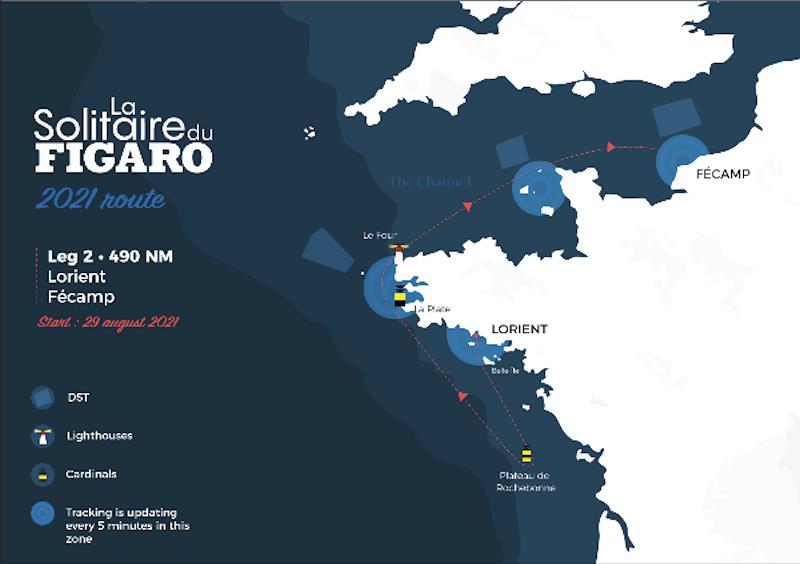
Stage 2 Of La Solitaire du Figaro beckons, a tricky, technical leg
by Andi Robertson 28 Aug 2021 21:19 BST
29 August 2021

52nd La Solitaire du Figaro Leg 2 © La Solitaire
The 490 nautical miles Stage 2 of the 52nd La Solitaire du Figaro, from Lorient to Fécamp, starts Sunday afternoon. It is a tricky, technical coastal stage which requires the passage of key tidal sections such as the Raz de Sein and the Raz Blanchard as well as a potentially hazardous finish in along the high cliffs to Fecamp.
Meteo specialist Britain's Will Harris, top rookie in 2016 and 22nd in 2019 introduces the leg:
After quite a close Leg 1, Leg 2 of the 52nd La Solitaire du Figaro will be certainly open some time gaps in the fleet. Passing several notorious tidal gates, you can be sure everyone will want to be in contact with the main peloton from the start to be sure to not get left behind.
In terms of the overall weather situation, we have had a stationary high pressure sat to the north of Ireland for the past week. It looks like it will stay there for the entirety of Leg 2 which will mean North-Easterly winds. It's quite an untypical situation to have winds from this direction for such a long time.
What it will mean for Leg 2 is that there is a lot of upwind since once around the corner of NW France it is a beat all the way up the channel to Fecamp. Looking back at Leg 1, the big upwind all the way back from La Corogne we saw some boatspeed gains being made by Pierre Quiroga (Skipper MACIF 2019) and also the Leg 1 winner Xavier Macaire who extended his lead to the finish. We may see these two doing something similar again, although with the complicated tides in the Channel, the element of strategy will be more dominant compared with boatspeed.
After leaving Lorient, the fleet will have probably their only spinnaker run to the SSE to Rochebonne in medium NE winds. With this direction, this wind tends to decrease in the daytime as the land heats up and then increase quite strongly overnight as the land cools and enhances the gradient breeze. By the time the fleet reach Rochebonne around midnight the wind should be above 20 knots and they will spend the rest of the night on a reach towards the Raz du Sein. The fleet will all be quite close together at this point since it is straightline sailing and predominantly about boatspeed.
When the fleet reach the first tidal gate of the Raz du Sein, it seems their timing will be quite favourable, and they will carry it with them. But it could also mean the small splits in the fleet will open. The first boats will touch the stronger positive tide first and extend. But also, later on once they are round the NW corner of France they will hold onto the positive east flowing tide for longer than those behind since the tide changes in the west first.
The fleet will now be into their long beat up to Fecamp and the next real opportunity will be in the strategy to get through the Straits of Alderney. Here, the tide can be up to 9 knots which is 1.5 times faster than what a Figaro 3 sails upwind. If one boat has to deal with 9 knots of negative tide even only for 30 minutes more, that could be a 4.5 mile loss. It will be crucial to get this section of the course right.
Depending on the timing with the tidal cycles, generally it is best to approach from the south in the shelter of Cherbourg peninsula when the tide is negative to avoid the strongest parts. But equally, if the tide is positive as the fleet approach the straights, we could see some of the fleet further behind miss the tidal gate and end up with small gaps turning into much bigger ones. Hopefully, we will see some splits in the fleet here as different strategies are played. Alexis Loison (Region Normandie) is always a good one to watch around here and knows the currents perfectly to play in his favour.
The best situation to be in will to have already been in the lead after rounding NW France. It means should the timing at Alderney play in your favour you could find yourself gaining a lot of time.
The final 70 mile section to the finish will be relatively straightforward and the positions will mostly be decided before this point. It will be worth giving your all before you round the Cherbourg Peninsula and not leaving much in the tank for the last bit. Although the wind is quite stable for this leg with no shutdowns expected, with these 2 major tidal gates its sure to be an exciting leg for the overall win.
Follow the departure from Lorient:
- 11:00 am Presentation of the skippers on stage in the village, followed by departure.
Viewpoints for the public:
- Departure (2:00 p.m.) and coastal route.
- Start given approximately 2km in front of Lomener (municipality of Ploemeur) - the coastal route will pass in front of Perello beach, passage near the tip of Talud, Kerroch beach, then another passage in front of Lomener.
Provisional timetable:
2:00 p.m. Passage of the "Pointe du Talud" buoy
2:10 p.m. / 2:15 p.m. Passage buoy "Basse des Bretons"
2:20 pm / 2:25 pm Passage buoy "Pointe de Ker-Biscart"
3.15pm / 3.30pm Eastern Passage of Groix
Follow the start remotely:
On the race's social networks, live with comments from sailor Karine Fauconnier (Lorient Grand Large Coordinator) on Youtube.